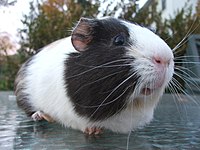
Photo from wikipedia
This study estimated the genetic parameters for human-directed behavior and intraspecific social aggression traits in growing pigs, and explored the phenotypic correlations among them. Data on 2,413 growing pigs were… Click to show full abstract
This study estimated the genetic parameters for human-directed behavior and intraspecific social aggression traits in growing pigs, and explored the phenotypic correlations among them. Data on 2,413 growing pigs were available. Pigs were mixed into new social groups of 18 animals, at 69±5.2 d of age and skin lesions (SL) were counted 24 h (SL24h) post-mixing. Individual behavioral responses to isolation in a weighing crate (CRATE) or when alone in an arena while a human directly approached them (IHAT) were assessed within 48h post-mixing. Additionally, pigs were tested for behavioral responses to the presence of a single human observer walking in their home pen in a circular motion (WTP) within one (T1) and 4 weeks post-mixing (T2) noting pigs that followed, nosed or bit the observer. Animal models were used to estimate genetic and phenotypic parameters for all studied traits. Heritabilities (h 2) for SL, CRATE and IHAT responses were low to moderate (0.07 to 0.29), with the highest h 2 estimated for speed of moving away from the approaching observer. Low but significant h 2 were estimated for nosing (0.09) and biting (0.11) the observer at T2. Positive high genetic correlations (rg) were observed between CRATE and IHAT responses (0.52 to 0.93), and within SL traits (0.79 to 0.91) while positive low to high correlations between the estimated breeding values (rEBV) were estimated within the WTP test (0.24 to 0.59) traits. Positive moderate rg were observed between CRATE and central and posterior SL24h. The rEBV of CRATE and IHAT test responses and WTP test traits were low, mostly negative (-0.21 to 0.05) and not significant. Low positive rEBV (0.06 to 0.24) were observed between SL and the WTP test traits. Phenotypic correlations between CRATE and IHAT responses and SL or WTP test traits were mostly low and not significant. Under the conditions of this study, h 2 estimates for all studied traits suggest they could be suitable as a method of phenotyping aggression and fear/boldness for genetic selection purposes. Additionally, genetic correlations between aggression and fear indicators were observed. These findings suggest selection to reduce the accumulation of lesions is likely to make pigs more relaxed in a crate environment, but to alter the engagement with humans in other contexts that depends on the location of the lesions under selection.
Journal Title: Journal of animal science
Year Published: 2023
Link to full text (if available)
Share on Social Media: Sign Up to like & get
recommendations!